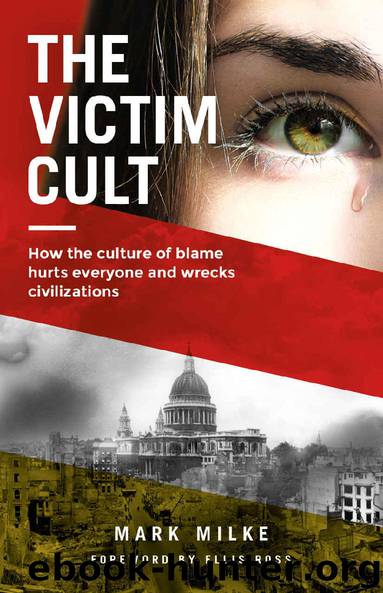The Victim Cult: How the culture of blame hurts everyone and wrecks civilizations by Mark Milke

Author:Mark Milke [Milke, Mark]
Language: eng
Format: epub
Tags: society and culture
Publisher: Thomas & Black
Published: 2019-10-18T22:00:00+00:00
Reverse victimization, grievance propaganda, and social justice
A turnover of state-sponsored advantages from one cohort to another often invigorates those newly in power. However, the desire to overturn statistical advantages runs the risk of misinterpreting why those advantages accrued, and not necessarily always due to past discrimination. The political desire to ensure perfect statistical equality is also unhelpful for people that wish to move into a colour-, race-, and ethnicity-blind future. But in Rwanda, state policy after independence ramped up the grievance culture. Hutu leaders were obsessed with the past and with achieving statistical perfection in the present. That combination was evident early on.
In 1959, the opposition party, Parmehutu, soon to take power and composed mainly of Hutus, issued an education manifesto demanding that the racial identification of children in schools be recorded.55 In 1960, Parmehutu’s Tenth Congress passed a resolution in favour of “ethnic redistribution.”56 The rationale was that too many students in high school and college, as well as in the main teacher training school, were Tutsi.57 According to one senior Hutu leader, such numerical tracking and rhetoric was justified because the Hutu had been disadvantaged for 400 years. The point of the 1959 social revolution, he asserted, “was to try and stop the injustice.”58 Similar to other African nations after independence, those deemed not indigenous were targeted: “Rwanda is the country of the Bahutu,” declared the leadership of Parmehutu in 1960, “and all those, white or black, Tutsi, European or from other origins [must] let go their feudal and imperialist goals.”59 With the 1961 elections and independence from Belgium (effective in 1962), the now-Hutu government attempted to reverse numerical Tutsi advantages and effort began in earnest: Ethnic quotas were introduced for education beyond elementary school,60 with Tutsi enrollment also to be limited in universities and government posts to reflect only the Tutsi proportion of the general population.61 The policy was known as iringaniza or “social justice.”62 The government made clear to all, including one former missionary, that just as the Tutsi excluded Hutu that “[the Hutu] were going to do exactly the same thing.”63
The Hutu government’s obsessive counting of statistical Tutsi advantages would continue and was soon paired with a long-lasting propaganda campaign, and the drive to level out statistical differences between Hutus and Tutsis would end up with Orwellian descriptions: “Ethnic rebalancing,” “clearing off,” removing a Tutsi “surplus,”64 and “ethnic equilibrium.”65 Also, in the early 1960s, the “cockroach” (inyenzi) slur first appeared. Those in government initially used the label against Rwanda’s first independence party, the main opposition party, which was made up mainly of Tutsis. Over time, the “cockroach” tag was applied to all Tutsis. Along with another unflattering label, “snake,” the language was another way to dehumanize Tutsis.66 The epithets were pockmarked by violence and political killings. In 1962, Hutu mobs killed between 1,000 and 2,000 Tutsi in the region of Byumba.67 In early 1963, the few Tutsi members of the national cabinet were fired and, after a show trial, executed for complicity with inyenzi terrorists.”
Download
This site does not store any files on its server. We only index and link to content provided by other sites. Please contact the content providers to delete copyright contents if any and email us, we'll remove relevant links or contents immediately.
| Coloring Books for Grown-Ups | Humor |
| Movies | Performing Arts |
| Pop Culture | Puzzles & Games |
| Radio | Sheet Music & Scores |
| Television | Trivia & Fun Facts |
The Social Psychology of Inequality by Unknown(2990)
Make Comics Like the Pros by Greg Pak(2883)
Stacked Decks by The Rotenberg Collection(2845)
Purple Hibiscus by Chimamanda Ngozi Adichie(2741)
The Queen of Nothing by Holly Black(2545)
The Art of Doom by Bethesda(2131)
Life of Elizabeth I by Alison Weir(2054)
Putin's Labyrinth(1989)
The Power of Habit: Why We Do What We Do in Life and Business by Charles Duhigg(1970)
Drawing Down the Moon by Margot Adler(1844)
Things Are What You Make of Them: Life Advice for Creatives by Adam J. Kurtz(1835)
Agency by William Gibson(1800)
Wall and Piece by Banksy(1797)
Art Of Atari by Tim Lapetino(1773)
Teaching to Transgress: Education as the Practice of Freedom (Harvest in Translation) by Bell Hooks(1743)
The Beatles Lyrics by Hunter Davies(1695)
The Pin-Up Art of Bill Ward by Bill Ward(1675)
Only What's Necessary: Charles M. Schulz and the Art of Peanuts by Chip Kidd(1667)
The Andy Warhol Diaries by Andy Warhol(1576)
